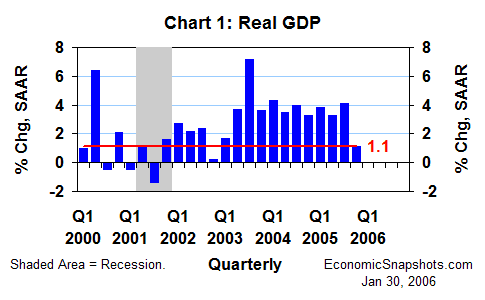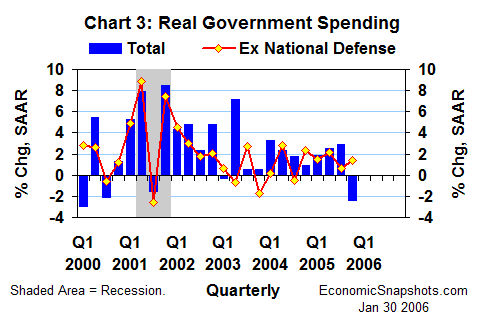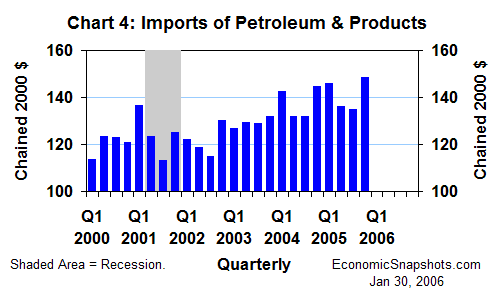
| Back to Index |
January 30, 2006 – U.S. real GDP edged up at a 1.1% annual rate in Q4 following a 4.1% gain in Q3 (Chart 1). We rarely see such weak GDP growth unless the economy is in trouble. Q4 may be an exception.

The slowing in Q4 real GDP growth seems to have stemmed from a confluence of negative developments in auto demand, national defense spending and oil imports – all notorious sources of volatility. A similar coincidence is unlikely in Q1. Thus, we should see stronger GDP growth then.
Real consumption rose at a 1.1% annual rate in Q4 after a 4.1% Q3 increase (Chart 2). Consumers’ contribution to real GDP growth fell by 2.1 percentage points in Q4, compared to Q3.

This Q4 consumer slowdown was narrowly based in a 44.9 % plunge in consumers’ real purchases of motor vehicles & parts (+12.7% in Q3). The latter can be blamed on the volatility in light vehicle demand caused by the automakers’ erratic pricing behavior. Excluding motor vehicles & parts, real consumption rose at a solid 4.2% annual rate in Q4 (+3.6% in Q3).
Light vehicle sales played a relatively minor role in Q4 real fixed investment growth. But, rising Q4 real auto inventories offset roughly half of the negative production effect of falling consumer auto demand. Thus, on net, motor vehicle output accounted for about 1 percentage point of the 3 percentage point slowing in Q4 real GDP growth.
Real government spending fell at an unusually steep 2.4% annual rate in Q4 after rising by 2.9% in Q3 (Chart 3). This reduction in government spending growth contributed another percentage point to the slowing in Q4 real GDP growth.

Q4’s government spending decline was driven entirely by a 13.1% plunge in real Federal national defense purchases (+10% in Q3). Excluding defense, real government spending rose at about a 1.4% annual rate in Q4 (+0.6% in Q3).
Real net exports of goods and services fell by $32.8B chained 2000 dollars in Q4 (-$3.3B in Q3) – contributing another percentage point or so to the slowing in Q4 real GDP growth. A $13.4B jump in real petroleum imports (Chart 4) accounted for about 40% of this total net export decline.

Bottom line: Excluding autos, defense spending and oil imports, real GDP growth would have been about 2.5 percentage points higher at about a 3.5% annual rate in Q4 (+3.2% in Q3).
Suzanne Rizzo